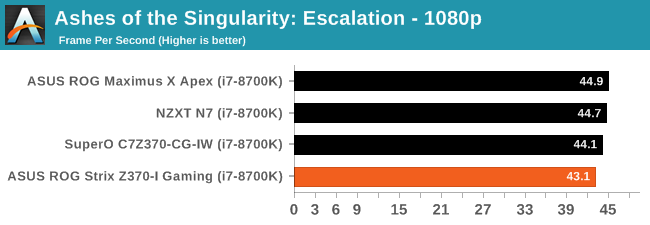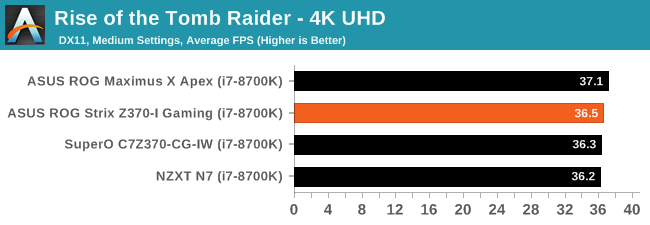The ASUS Z370-I Gaming Review: Mini-Me Mega Motherboard
by Joe Shields on May 21, 2018 11:00 AM EST- Posted in
- Motherboards
- Intel
- Mini ITX
- Asus
- Coffee Lake
- Z370
- Z370-I Gaming
Gaming Performance
Ashes of the Singularity
Ashes of the Singularity is a Real Time Strategy game developed by Oxide Games and Stardock Entertainment. The original AoTS was released back in March of 2016 while the standalone expansion pack, Escalation, was released in November of 2016 adding more structures, maps, and units. We use this specific benchmark as it relies on both a good GPU as well as on the CPU in order to get the most frames per second. This balance is able to better display any system differences in gaming as opposed to a more GPU heavy title where the CPU and system don't matter quite as much. We use the default "Crazy" in-game settings using the DX11 rendering path in both 1080p and 4K UHD resolutions. The benchmark is run four times and the results averaged then plugged into the graph.


Our AOTS results here on the Z370 platform are just as close together as our results on the X299 platform. The Z370-I managed 43.1 FPS in 1080p and 32.4 FPS in 4K.
Rise of the Tomb Raider
Rise of the Tomb Raider is a third-person action-adventure game that features similar gameplay found in 2013's Tomb Raider. Players control Lara Croft through various environments, battling enemies, and completing puzzle platforming sections, while using improvised weapons and gadgets in order to progress through the story.
One of the unique aspects of this benchmark is that it’s actually the average of 3 sub-benchmarks that fly through different environments, which keeps the benchmark from being too weighted towards a GPU’s performance characteristics under any one scene.


Rise of the Tomb Raider results for the Z370-I Gaming in 1080p are 93.1 FPS and 36.5 FPS inin 4K. The results are in close proximity to the others we have tested so far. So far, all of these runs are within a typical run variance.












37 Comments
View All Comments
Chaitanya - Monday, May 21, 2018 - link
Price premium for the compact build just doesnt justify the cooling compromises that mini-ITX brings to the table especially for people living in hot climatic regions of the globe where ambient temps can cross 40Deg C.jordanclock - Monday, May 21, 2018 - link
And...? So this one product might not be suitable for people using tiny air cooled cases in warm places? And who are you to say what is and isn't justified for different people? Liquid cooling pretty much negates the space issues. Also a mini-ITX board does not need to be used in a mini-ITX case.tarqsharq - Monday, May 21, 2018 - link
Yeah, it seems odd to complain about cooling problems when you're already at 104F... might want to invest in AC at that point or just get a massive case with tons of fans, not conducive to ITX at all!MDD1963 - Monday, May 21, 2018 - link
"Also a mini-ITX board does not need to be used in a mini-ITX case."I'm sure there's at least one tard looking to stuff one into Corsairs largest ATX doublewide case right now....
meacupla - Tuesday, May 22, 2018 - link
Do you mean the Obsidian 1000D? Because that case has room for an E-ATX and mITXSamus - Thursday, May 24, 2018 - link
Haha that's exactly what I was thinking. Dual PC's in a PC!Joe Shields - Monday, May 21, 2018 - link
I'm not sure what one has to do with the other. One isn't paying a premium for the cooling, or less of it - that simply comes with the territory of the Mini-ITX board in general.Clearly, if one is living in such an area where your inside temperature is 40C, additional cooling considerations are likely warranted, almost regardless of the build size. I do not understand the root of that comment...
Chaitanya - Monday, May 21, 2018 - link
One of the main selling point of Mini-Itx motherboards is smaller and compact PC builds and thats how both motherboard and case manufacturers have been marketing it. So if you want to take full advantage of smaller system then going the route of smaller Mini-Itx cases is necessary which means a restriction on size of cooler that can be used. And using tower style Itx cases defeats the purpose as one can easily go to micro Atx form factor without increasing the volume of pc case too much.Ratman6161 - Monday, May 21, 2018 - link
I guess we can, or at least should, agree that there isn't a one size fits all and that Mini-ITX in general falls into the "not for everybody" category. Then again, If I built my wife a system in a mammoth full tower case, I'd probably be getting some very dirty looks to...so that is also a "not for everybody" sort of build.All that said, this article is actually a motherboard review. I am personally interested in a Mini-ITX build, but for a more mainstream, non-gaming sort of system. so what I'd like to see is a different article that addresses Mini-ITX in general and the issues, pros and cons surrounding it; selecting components that fit in a reasonable case, coolers that fit etc. One thing I would have liked to have seen in this particular article - even though its a motherboard review - is what it looks like actually mounted in a case and using components one might actually be able to fit in such a case. Notably, the GTX 980 isn't something that you could actually use in a Mini-ITX build so why benchmark with it? Or am I wrong about that?
Ratman6161 - Monday, May 21, 2018 - link
Just looked again. Ditto on the power supply and dual 120MM cooler. If they wouldn't fit in a Mini-ITX case why use them for testing the motherboard intended for such a case?